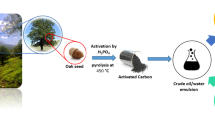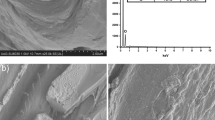Abstract
This work aims to evaluate the removal of pharmaceutical drug using discarded biodiesel waste–derived lignocellulosic-based activated carbon biomaterial. Lignocellulosic-based activated carbon (LAC) biomaterial was prepared from Jatropha shell (biodiesel processing waste) by a zinc chloride activation method. The LAC biomaterial was characterized using various techniques including powder XRD, FT-IR, SEM-EDAX, and BET analysis. LAC biomaterial was applied to examine the adsorption of sulfamethoxazole (SMZ) drug in aqueous solution under ambient temperature. Various experimental parameters such as the effect of pH, treatment time, adsorbate concentration, and LAC dose of adsorption experiments were thoroughly examined and optimized. Under the optimal conditions, LAC biomaterial showed the maximum adsorption removal efficiency of SMZ drug. The kinetic models of Lagergren first-order, pseudo-second-order, intraparticle diffusion, and Bhangam’s equation for SMZ removal onto LAC were used to recognize the probable mechanism of adsorption manner. From the experimental results, the Freundlich isotherm model (Kf = 83.56 mg g−1 (L mg−1)1/n) shows similar fit than the Langmuir (Q0 = 206.2 mg g−1) and Dubinin-Radushkevich (Qm = 150.69 mg g−1) condition models of adsorption isotherms. The rate constants of adsorption were found to confirm the pseudo-first-order kinetic and Bhangam’s models with a significant correlation. The separation factor (RL) showed the favorable condition of the adsorption isotherm for the experimental system. The desorption results indicate that the ionic molecular exchange of SMZ from the hydroxyl group of LAC surface plays an important role in the recycling processes. Therefore, these results proved that the prepared low-cost LAC biomaterial could be used as an efficient adsorption material for the effective removal of pharmaceutical drugs in aqueous samples.








Similar content being viewed by others
References
Bandura L, Kołodyńska D, Franus W (2017) Adsorption of BTX from aqueous solutions by Na-P1 zeolite obtained from fly ash. Process Saf Environ Prot 109:214–223. https://doi.org/10.1016/j.psep.2017.03.036
Barkakati P, Begum A, Das ML, Rao PG (2010) Adsorptive separation of ginsenoside from aqueous solution by polymeric resins: equilibrium, kinetic and thermodynamic studies. Chem Eng J 161:34–45. https://doi.org/10.1016/j.cej.2010.04.018
Caliskan E, Gokturk S (2010) Adsorption characteristics of sulfamethoxazole and metronidazole on activated carbon. Sep Sci Technol 45:244–255. https://doi.org/10.1080/01496390903409419
Chang EE, Wan JC, Kim H et al (2015) Adsorption of selected pharmaceutical compounds onto activated carbon in dilute aqueous solutions exemplified by acetaminophen, diclofenac, and sulfamethoxazole. Sci World J:1–11. https://doi.org/10.1155/2015/186501
Dąbrowski A (2001) Adsorption—from theory to practice. Adv Colloid Interf Sci 93:135–224. https://doi.org/10.1016/S0001-8686(00)00082-8
Du T, Zhang G, Lu S, et al (2018) Adsorptive removal of sulfamethazine and sulfamethoxazole from aqueous solution by hexadecyl trimethyl ammonium bromide modified activated carbon. Colloids Surfaces A Physicochem Eng Asp. https://doi.org/10.1016/j.colsurfa.2018.12.041
Dubinin MM (1960) The potential theory of adsorption of gases and vapors for adsorbents with energetically nonuniform surfaces. Chem Rev 60:235–241. https://doi.org/10.1021/cr60204a006
Dubinin MM, Radushkevich LV (1947) The equation of the characteristic curve of activated charcoal. Proc Acad Sci Phys Chem Sect 55:331. https://doi.org/10.4236/ojs.2014.41001
Fan L, Zhang Y, Li X et al (2012) Removal of alizarin red from water environment using magnetic chitosan with Alizarin Red as imprinted molecules. Colloids Surfaces B Biointerfaces 91:251–257. https://doi.org/10.1016/j.colsurfb.2011.11.014
Freundlich H (1907) Uber die Adsorption in Lösungen. Z Phys Chem 57U:1. https://doi.org/10.1515/zpch-1907-5723
Gadipelly C, Perez-Gonzalez A, Yadav GD et al (2014) Pharmaceutical industry wastewater: review of the technologies for water treatment and reuse. Ind Eng Chem Res 53:11571–11592. https://doi.org/10.1021/ie501210j
Galán J, Rodriguez A, Gomez JM et al (2013) Reactive dye adsorption onto a novel mesoporous carbon. Chem Eng J 219:62–69. https://doi.org/10.1016/j.cej.2012.12.073
Ghaedi M, Hassanzadeh A, Kokhdan SN (2011) Multiwalled carbon nanotubes as adsorbents for the kinetic and equilibrium study of the removal of Alizarin Red S and morin. J Chem Eng Data 56:2511–2520. https://doi.org/10.1021/je2000414
Ghasemi M, Ghasemi N, Zahedi G, Alwi SRW, Goodarzi M, Javadian H (2014) Kinetic and equilibrium study of Ni(II) sorption from aqueous solutions onto Peganum harmala-L. Int J Environ 11:1835–1844. https://doi.org/10.1007/s13762-014-0617-9
Gonzalez-Garcia P (2018) Activated carbon from lignocellulosics precursors: a review of the synthesis methods, characterization techniques and applications. Renew Sust Energ Rev 82:1393–1414. https://doi.org/10.1016/j.rser.2017.04.117
Gupta VK, Gupta B, Rastogi A et al (2011) Pesticides removal from waste water by activated carbon prepared from waste rubber tire. Water Res 45:4047–4055. https://doi.org/10.1016/j.watres.2011.05.016
Han X, Wang W, Ma X (2011) Adsorption characteristics of methylene blue onto low cost biomass material lotus leaf. Chem Eng J 171:1–8. https://doi.org/10.1016/j.cej.2011.02.067
Ji L, Wan Y, Zheng S, Zhu D (2011) Adsorption of tetracycline and sulfamethoxazole on crop residue-derived ashes: implication for the relative importance of black carbon to soil sorption. Environ Sci Technol 45:5580–5586. https://doi.org/10.1021/es200483b
Kadam AA, Lade HS, Patil SM, Govindwar SP (2013) Low cost CaCl2 pretreatment of sugarcane bagasse for enhancement of textile dyes adsorption and subsequent biodegradation of adsorbed dyes under solid state fermentation. Bioresour Technol 132:276–284. https://doi.org/10.1016/j.biortech.2013.01.059
Karagöz S, Tay T, Ucar S, Erdem M (2008) Activated carbons from waste biomass by sulfuric acid activation and their use on methylene blue adsorption. Bioresour Technol 99:6214–6222. https://doi.org/10.1016/j.biortech.2007.12.019
Kumar AJ, Singh RP, Fu D, Namasivayam C (2017) Comparison of physical- and chemical-activated Jatropha curcas husk carbon as an adsorbent for the adsorption of Reactive Red 2 from aqueous solution. Desalin Water Treat 95:308–318. https://doi.org/10.5004/dwt.2017.21255
Liu D, Zhang W, Lin H et al (2016) A green technology for the preparation of high capacitance rice husk-based activated carbon. J Clean Prod 112:1190–1198. https://doi.org/10.1016/j.jclepro.2015.07.005
Lu L, Gao M, Gu Z et al (2014a) A comparative study and evaluation of sulfamethoxazole adsorption onto organo-montmorillonites. J Environ Sci 26:2535–2545. https://doi.org/10.1016/j.jes.2014.04.007
Lu L, Gao M, Gu Z et al (2014b) A comparative study and evaluation of sulfamethoxazole adsorption onto organo-montmorillonites. J Environ Sci (China). https://doi.org/10.1016/j.jes.2014.04.007
Mall ID, Srivastava VC, Agarwal NK, Mishra IM (2005) Removal of Congo Red from aqueous solution by bagasse fly ash and activated carbon: kinetic study and equilibrium isotherm analyses. Chemosphere. 61:492–501. https://doi.org/10.1016/j.chemosphere.2005.03.065
Mogolodi Dimpe K, Mpupa A, Nomngongo PN (2018) Microwave assisted solid phase extraction for separation preconcentration sulfamethoxazole in wastewater using tyre based activated carbon as solid phase material prior to spectrophotometric determination. Spectrochim Acta - Part A Mol Biomol Spectrosc 188:341–348. https://doi.org/10.1016/j.saa.2017.07.039
Moral-Rodríguez AI, Leyva-Ramos R, Ocampo-Pérez R et al (2016) Removal of ronidazole and sulfamethoxazole from water solutions by adsorption on granular activated carbon: equilibrium and intraparticle diffusion mechanisms. Adsorption 22:89–103. https://doi.org/10.1007/s10450-016-9758-0
Nahar K, Ozores-Hampton M (2011) Jatropha: an alternative substitute to fossil fuel. Inst Food Agric Sci:1–10 http://edis.ifas.ufl.edu
Nam S-W, Choi D-J, Kim S-K, Her N, Zoh KD (2014) Adsorption characteristics of selected hydrophilic and hydrophobic micropollutants in water using activated carbon. J Hazard Mater 270:144–152. https://doi.org/10.1016/j.jhazmat.2014.01.037
Naseem K, Huma R, Shahbaz A et al (2019) Extraction of heavy metals from aqueous medium by husk biomass: adsorption isotherm, kinetic and thermodynamic study. Z Phys Chem 233:201–223. https://doi.org/10.1515/zpch-2018-1182
Nielsen L, Biggs MJ, Skinner W, Bandosz TJ (2014) The effects of activated carbon surface features on the reactive adsorption of carbamazepine and sulfamethoxazole. Carbon 80:419–432. https://doi.org/10.1016/j.carbon.2014.08.081
Oo CW, Jain K (2019) Chromium (III) adsorption from aqueous solution by rhizophora apiculata tannins. Indones J Chem 7:180–184. https://doi.org/10.22146/ijc.21695
Park NK, Lee YJ, Han GB et al (2008) Synthesis of various zinc oxide nanostructures with zinc acetate and activated carbon by a matrix-assisted method. Colloids Surfaces A Physicochem Eng Asp 313-314:66–71. https://doi.org/10.1016/j.colsurfa.2007.04.074
Rostamian R, Behnejad H (2016) A comparative adsorption study of sulfamethoxazole onto graphene and graphene oxide nanosheets through equilibrium, kinetic and thermodynamic modeling. Process Saf Environ Prot 102:20–29. https://doi.org/10.1016/j.psep.2015.12.011
Sharma DK, Pandey AK, Lata (2009a) Use of Jatropha curcas hull biomass for bioactive compost production. Biomass Bioenergy 33:159–162. https://doi.org/10.1016/j.biombioe.2008.05.002
Sharma N, Kaur K, Kaur S (2009b) Kinetic and equilibrium studies on the removal of Cd2+ ions from water using polyacrylamide grafted rice (Oryza sativa) husk and (Tectona grandis) saw dust. J Hazard Mater 163:1338–1344. https://doi.org/10.1016/j.jhazmat.2008.07.135
Sophia AC, Lima EC (2018) Removal of emerging contaminants from the environment by adsorption. Ecotoxicol Environ Saf 150:1–17. https://doi.org/10.1016/j.ecoenv.2017.12.026
Sureshkumar MV, Namasivayam C (2008) Adsorption behavior of Direct Red 12B and rhodamine B from water onto surfactant-modified coconut coir pith. Colloids Surfaces A Physicochem Eng Asp 317:277–283. https://doi.org/10.1016/j.colsurfa.2007.10.026
Tonucci MC, Gurgel LVA, de Aquino SF (2015) Activated carbons from agricultural byproducts (pine tree and coconut shell), coal, and carbon nanotubes as adsorbents for removal of sulfamethoxazole from spiked aqueous solutions: kinetic and thermodynamic studies. Ind Crop Prod 74:111–121. https://doi.org/10.1016/j.indcrop.2015.05.003
Wang S, Zhu ZH, Coomes A, Haghseresht F, Lu GQ (2005) The physical and surface chemical characteristics of activated carbons and the adsorption of methylene blue from wastewater. J Colloid Interface Sci 284:440–446. https://doi.org/10.1016/j.jcis.2004.10.050
Wang T, Tan S, Liang C (2009) Preparation and characterization of activated carbon from wood via microwave-induced ZnCl2 activation. Carbon 47:1880–1883. https://doi.org/10.1016/j.carbon.2009.03.035
Zhang J-Z (2011) Avoiding spurious correlation in analysis of chemical kinetic data. ChemComm 47:6861–6863. https://doi.org/10.1039/c1cc11278c
Funding
This study was supported by the Ministry of Science and Technology (Taiwan) Research Grant (107-2113-M-037-007-MY2); the Research Center for Environmental Medicine, Kaohsiung Medical University, Kaohsiung, Taiwan (from “The Featured Areas Research Center Program within the framework of the Higher Education Sprout Project” by the Ministry of Education (MOE) in Taiwan); and the NSYSU-KMU collaboration research project (NSYSU-KMU 107-I004) (Taiwan) research grant.
Author information
Authors and Affiliations
Corresponding author
Ethics declarations
Conflict of interest
The authors declare that they have no conflict of interest.
Additional information
Responsible editor: Tito Roberto Cadaval Jr
Publisher’s note
Springer Nature remains neutral with regard to jurisdictional claims in published maps and institutional affiliations.
Rights and permissions
About this article
Cite this article
Ganesan, S., Karthick, K., Namasivayam, C. et al. Discarded biodiesel waste–derived lignocellulosic biomass as effective biosorbent for removal of sulfamethoxazole drug. Environ Sci Pollut Res 27, 17619–17630 (2020). https://doi.org/10.1007/s11356-019-07022-9
Received:
Accepted:
Published:
Issue Date:
DOI: https://doi.org/10.1007/s11356-019-07022-9




